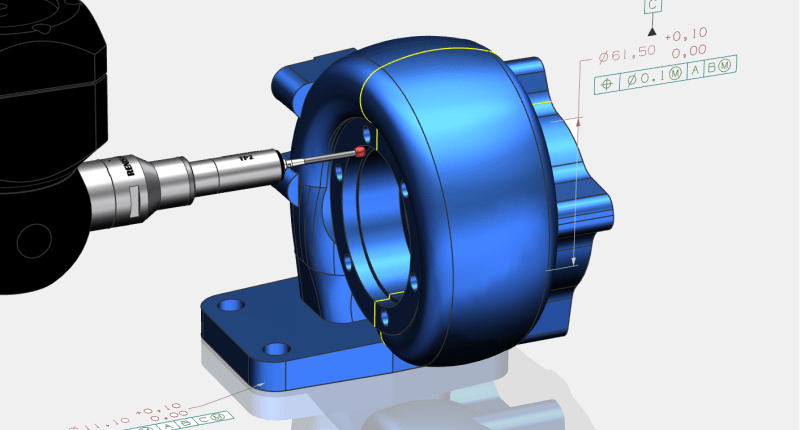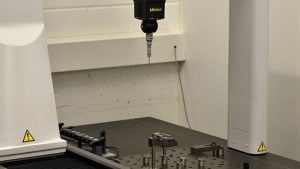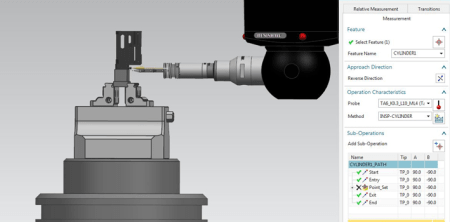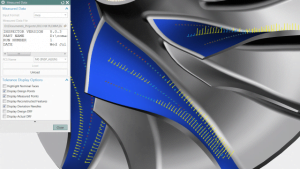
Precision Manufacturer Integrates Inspection Programming Digitalizing Production Operations
C-Mill is a leading technology and services firm in cutting complex parts for the medical technology, watch, fluid systems, aerospace, and technology markets. The firm provides manufacturing advice to customers in the early stages of product development and performing high precision production of complex parts using high-speed milling technologies.
“The idea behind C-Mill is to combine these software technologies with high-speed milling, hence the name,” says Ziswiler. “This allowed us to offer customers a combination of top precision and short turnaround that was virtually unknown at the time.”
C-Mill proved a success, particularly with customers in the medical equipment and aerospace industries. They typically have demanding quality requirements, handle comparatively low quantities on tight deadlines and often use exotic materials that are difficult to machines, such as titanium, Inconel®, and tantalum.
“Using NX software to create a digital twin of both the parts to produce and the production equipment, we can develop and verify machining strategies well in advance of the production process,” Ziswiler explains. “This allows us to provide valuable advice to customers during the early stages of product creation so they can modify the designs for improved manufacturability.”
Measuring Quality Control as Part of the Process
Measuring the milled components using a coordinate measuring machine (CMM) is an integral part of C-Mill’s part production process. “Being in command of the entire process chain, from CAD/CAM and HSC milling to CNC measuring, is indispensable for meeting the elevated quality requirements of our customers in the medical device and aerospace industries,” says Ziswiler. “We also need documented evidence of the measurements to fulfill our ISO 13485 certificate for medical parts.”
 Until recently, part inspection using the CMM was an independent operation almost entirely detached from the overall parts production process.
Until recently, part inspection using the CMM was an independent operation almost entirely detached from the overall parts production process.
“While we had been programming our machining centers offline during production using computer-aided manufacturing software NX CAM from Siemens Digital Industries Software from the start, programming our sophisticated measuring equipment was a tedious process,” says Ziswiler. The process involved exporting 2D drawings from the 3D CAD model and manually augmenting all dimensions with dimensional, shape, and position tolerances. Programming required a physical part. The CMM needed to be programmed online for every part, and until it was finished, the machine stood idle.
This time-consuming procedure required a dedicated measuring expert for CMM programming. It was also at variance with C-Mill’s principle of assigning a person for each part to manage the entire production process. As the measuring machine’s output came in a proprietary format, analyzing measurement data in the CAD environment also required manual work. So did feeding the information back to the 3D model.
Ziswiler had experienced the benefits of a seamless process chain from the 3D model to the finished part using NX CAM software for offline machine tool programming. He turned to Siemens Digital Industries Software solution partner Cytrus AG to inquire about software for the existing measuring machine’s offline programming.
Seamless CMM integration
“The solution was not very hard to find. The CMM inspection programming capabilities within NX software provide a state-of-the-art solution for offline measuring machine programming,” says Christoph Renker, managing director of Cytrus. “NX CMM Inspection Programming streamlines the entire CMM inspection program development and measurements analysis process.”
It was an easy addition to their existing manufacturing software system since C-Mill was already using NX CAM to program their CNC machine tools. The NC programmers took advantage of the HSC methods in NX to maximize material removal rate and minimize cutting time. These high-speed machining techniques helped the company compress lead time, reduce production costs and stay competitive.
The process covered by NX CMM Inspection Programming starts by defining features and creating paths and goes all the way through program generation and validation, and, ultimately, to analyze the measured data. Therefore, C-Mill can use one software system to digitalize and automate its entire operation by establishing a digital thread. This means they have one familiar environment, making it easy to use and minimizing the need for training. Further, C-Mill can drive the entire process using a single 3D model, which improves accuracy due to the associativity to the 3D model. They can collaborate more efficiently with a shorter turnaround time.

Using NX CMM eliminates the need to edit drawings manually. It uses the product and manufacturing information (PMI) – geometric dimensions and tolerances, 3D annotation and dimensions, surface finish, and material specifications – associated with the 3D model in NX CAD to generate inspection programs automatically. By applying their own standard inspection path methods, tools, and project templates, users can further automate the process.
Like machine tools, CMM machines are different and often use proprietary data and instruction formats. Like CAM software, NX CMM software can create machine instructions in DMIS or machine-specific formats with postprocessors. NX also provides inspection program verification and model-based kinematic machine simulation. Using this digital twin of the inspection setup, the company can make sure the inspection programs are collision-free and match the intended measurement strategy before sending them to the shop floor. Siemens also offers CMM execution software to drive coordinate- measuring machines using the output from NX CMM.
Achieving Improved Efficiency with Digitalization
“C-Mill was the first customer in Switzerland to use the NX software CMM inspection programming capabilities,” says Renker. “To ensure successful implementation, we called in Siemens Digital Industries Software solution partner Janus Engineering, who had already gathered experience in this field.”
Although seamlessly integrating CMM programming with the digital enterprise meant aligning the different thinking methods that underlie milling and measuring programs, the task was quickly completed. Using the new capabilities also required testing and training, and approval by the customers, as this transition constituted a significant change in procedures.

“Creating the CMM programs as part of the same course of action as CNC machine tool programming has greatly improved our overall manufacturing process,” says Ziswiler. “Offline CMM programming keeps the CMM available for inspection tasks whenever required, which also means that inspections can be performed the moment a part leaves the milling center, so the machine is not kept idling.”
Ziswiler points out another way in which integrating the CMM programming process saves time: “If the same person programming the machine tools is also in charge of programming the CMM, that person knows which positions are critical and which are not,” he says. “This leads to much more efficient measuring processes as fewer measuring positions are needed to provide representative results.”
According to early estimates by Ziswiler, the automated NX CMM inspection programming capabilities cut measuring equipment downtime by 80 percent.
However, in his opinion, this is not the main benefit of the integrated solution: “Using the associativity between NX CAD, CAM and CMM applications means eliminating errors and the ability to adapt inspection programs in case of design changes quickly,” says Ziswiler. “Having machining as well as measuring programs and data within the same repository in our enterprise resource planning system will also make it easier for us to generate cross-disciplinary reports.”
The opportunity to directly feed inspection data back to the 3D NX model for visualization and analysis also makes it easier to provide customers with more comprehensive documentation.
“Integrating inspection programming and simulation with our Siemens Digital Industries Software infrastructure is a logical step toward digitalization,” Ziswiler says. “It makes it easier for us to provide our customers with high quality as well as all the documentation they require despite shorter lead-time goals.”
“Siemens’ NX software is supporting our efforts to streamline and automate our entire production workflow from CAD models to finished and measured parts.”
For more information: www.plm.automation.siemens.com

Don’t hesitate to contact Thanh for advice on automation solutions for CAD / CAM / CAE / PLM / ERP / IT systems exclusively for SMEs.
Luu Phan Thanh (Tyler) Solutions Consultant at PLM Ecosystem Mobile +84 976 099 099
Web www.plmes.io Email tyler.luu@plmes.io
